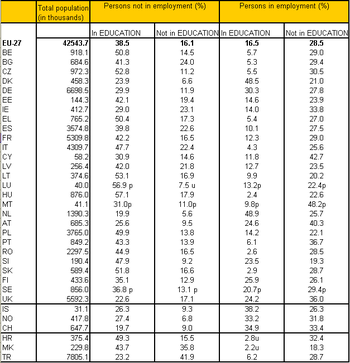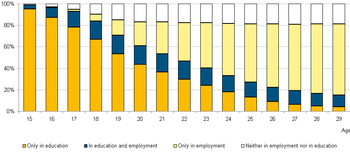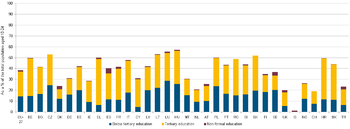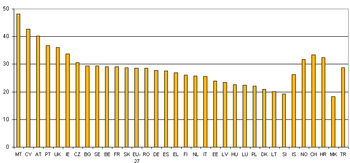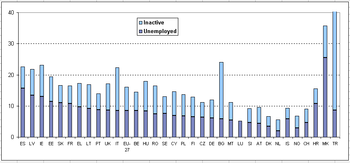- Data from 2010, most recent data: Further Eurostat information, Main tables and Database.
Young people - school/work/inactivity - what are they doing?
After the age of 18, compulsory schooling ends in all European countries. Thereafter, young Europeans can be in a number of different situations regarding education and employment. How many young people are students and how many are combining studies and work? Which proportion of young people has left education and is working? How many are those outside education and without employment?
The analysis presented below is based on the EU Labour Force Survey 2009 data and focuses on the young population aged 18-24 years.
This article is the first of a set of 'Statistics explained’ aiming to describe the situation of young people regarding their transition from education to employment.
Main statistical findings
The population of young people aged 18-24 can be divided into four broad categories as regards their situation concerning education and labour status (see table 1). Please note that education includes formal and non-formal education.
• More than two thirds of young Europeans aged 18-24 are either only in education or already exclusively in employment. In 2009, in the EU, 16.4 million young persons aged 18-24 were exclusively in education, accounting for 39 % of the age class. Those who were only in employment (for at least 1 hour a week) numbered 12.2 million (29% of the age class).
But outside these two "classical" stages of the transition from school to work, two other situations and groups of young people can be distinguished.
• Around 7 million of the 18-24-year-olds (16.5%) are studying and working at the same time. Some students work in conjunction with their education (e.g. as apprentices or trainees), others do it to gain experience, to finance their studies or simply to earn money.
• Another almost 7 million (16%) have left education and are without employment. A little more than a half of them are unemployed and the rest are economically inactive.
The composition of the population according to the four above categories (Figure 1) evolves with age. In the EU-27, in 2009, almost all 15-yearolds were exclusively students, whereas more than 90% of those aged 29 had already left education.
The highest proportions of persons combining both education and employment (15-17%) can be observed between the ages of 17 and 24 years. In this group, there are "students working" and "workers studying", including also apprentices and trainees.
In the EU-27, in 2009, 39% of 18-24-year-olds were exclusively in education
A "classical" model of transition from school to work applies when young people start working only after completing their highest level of education. In such a model, persons rarely combine education with employment.
In 2009, in the EU, 16.4 million young persons aged 18-24 were exclusively in education: 37.5% of them were attending programmes below tertiary education (i.e. up to ISCED level 4) and 59% attended tertiary education (ISCED levels 5 and 6), whereas 3.5% were in non-formal education (Figure 2). In total, in the EU-27, 39% of the population aged between 18 and 24 had in 2009 not begun their transition towards employment, i.e. they were only in education without being employed, even for one hour a week.
In nearly all European countries, most young persons who were exclusively in education were attending tertiary education. But the picture was different in Denmark, Germany, Luxembourg, Malta, Finland and Sweden, where more than 50% were still in upper-secondary education or post-secondary non-tertiary education. This reflects the existence of different educational systems. In Sweden, for example, Kommunal Vuxenutbildning/ Folkhogskola (ISCED level 3 or 4) begins at age 19 and may end after the age of 21.
Among the young Europeans being exclusively in education, there is a proportion who are looking for a job - some are doing it with the aim to increase their income, while others, who graduated earlier, may have undertaken current studies (either formal or non-formal) because they did not succeed in finding a job but still expect to do so. Students looking for a job (either unemployed or passive job seekers) accounted for more than 10% of young people being exclusively in education in the Nordic countries, the United Kingdom, Spain, the Netherlands, Latvia, Austria and Switzerland.
16.5 % of 18-24-year-olds combined education and employment
In 2009, 6.9 million young Europeans aged 1824 were combining education and employment (for at least one hour a week). In this respect, strong discrepancies were found between European countries (Figure 3). In Italy, Hungary, Slovakia and Romania, combining education and employment was very rare - concerned less than 5% of the age class. But this percentage was between 20 and 30% in Sweden, the United Kingdom, Slovenia, Austria and Finland and stood even above 30% in Denmark and the Netherlands (nearly 50% in both countries), Germany, Iceland, Norway and Switzerland.
Young persons combining education and employment can be divided into two broad categories.
The first category includes those with a temporary contract covering a period of training - this is for instance the case of apprentices or trainees. In the 18-24 age group, at EU-level, 5% had such temporary contracts (mainly at upper-secondary level). In Germany and Switzerland, this percentage was the highest - exceeded 20%.
The second category comprises students working with other types of contracts (permanent or temporary job for reasons other than training). The time spent by students in employment provides a broad approximation of the intensity of these two activities in young people’s lives. In countries with the higher proportions of young people combining education and employment - Denmark, the Netherlands, Iceland and Norway, the majority of them worked part-time (less than 30 hours a week). They can be named "students working". Those who usually spend more than 30 hours a week at work may be qualified as ‘workers studying’. This situation is observed in 13 EU MS, in particular in the countries with the small proportions of young persons combining education and employment in general (many East and South countries).
29 % of the population aged 18-24 who was already exclusively in employment
In 2009, the EU-27 counted around 12.2 million young persons aged 18-24 being exclusively in employment. They accounted for nearly 29% of the age class at EU-level, going from 19% in Slovenia to 48% in Malta (Figure 4). More than 30% of the population aged 18-24 was exclusively in employment in Malta, Cyprus, Austria, the United Kingdom, Portugal, Ireland, the Czech Republic and Norway.
Being in employment does not automatically mean that young people have jobs matching their qualifications or desires. Moreover, as they have joined the labour market at a young age, newcomers to the labour market may not have a sufficient education level to take up the challenges of the knowledge-based economy.
Nearly 16 % of the population aged 18-24 was neither in employment nor in education
In 2009, the EU-27 counted around 6.8 million young persons aged 18-24 neither in employment, education or training (NEET). Although some of them become inactive after leaving school for family or other personal reasons, NEETs are of particular interest to policy-makers. Indeed, most of them can presumably be considered as facing difficulties in finding a job or as being at risk of not finding one.
At EU level, around 9% of 18-24-year-olds were no longer in education and actively looking for a job (unemployed) and nearly 8% were considered as ‘inactive’ (Figure 5). Among the latter category, a very small proportion are considered as ‘passive job seekers’, i.e. looking for a job but not complying with all the conditions to be considered as unemployed according to the ILO definition.
The highest proportions of young persons aged 18-24 neither in employment nor in education who were unemployed were found in Spain, Latvia, Ireland, Estonia, Slovakia, France and Greece (ranging from 16% to 10%). This share stood above 25% in the former Yugoslav Republic of Macedonia.
The ‘inactive’ category accounted for a large share of young persons neither in employment nor in education in Bulgaria, Italy and Turkey as well the Netherlands and Norway. Among personal reasons, family responsibilities were a key reason for not seeking employment among the inactive NEET population. In half of the Member States, looking after children or having other personal or family responsibilities were mentioned as reasons by more than one third of inactive NEET persons aged 18-24. A strong gender dimension was found in the reasons for not looking for a job among the NEET population. Indeed, at EU level and in numerous Member States, personal reasons and especially family responsibilities explained why a large part of inactive NEET women (51%) were not looking for a job. These reasons were mentioned by only 9% of young men. In contrast, the proportion of the inactive NEET population who thought that seeking employment was not worthwhile because of a lack of opportunities was twice as high among young men as among young women.
Data sources and availability
The source of the data presented here is the Labour Force survey (LFS), a large sample survey among private households which provides detailed annual and quarterly data on employment, unemployment and inactivity.
The data can be broken down along many dimensions including age, sex, educational attainment, and distinctions between permanent/temporary and full-time/part-time employment. It covers people aged 15 and over in the EU, European Free Trade Association (EFTA) – except Liechtenstein – and Candidate Countries.
The levels of education are described in the international standard classification of education (ISCED) which is the basis for international education statistics. The current version, ISCED 97, distinguishes seven levels of education: pre-primary education (level 0); primary education (level 1); lower secondary education (level 2); upper secondary education (level 3); post-secondary non-tertiary education (level 4); tertiary education (first stage) (level 5); tertiary education (second stage) (level 6).
The data on young people who are neither in employment nor in education and training (NEET) corresponds to the percentage of the population of a given age group and sex who is not employed and not involved in further education or training.
Context
<context of data collection and statistical results: policy background, uses of data, …>
Further Eurostat information
Publications
Database
- Education and training, see:
- Educational attainment, outcomes and returns of education
- Transition from education to work, early leavers from education and training
Dedicated section
Source data for tables, figures and maps on this page (MS Excel)
Methodology / Metadata
- esms metadata file: Educational attainment, outcomes and returns from education
Other information
<Regulations and other legal texts, communications from the Commission, administrative notes, Policy documents, …>
- Regulation 1737/2005 of DD Month YYYY on ...
- Council Directive 86/2003 of DD Month YYYY
- Commission Decision 86/2003 of DD Month YYYY
<For other documents such as Commission Proposals or Reports, see EUR-Lex search by natural number>
<For linking to database table, otherwise remove: {{{title}}} ({{{code}}})>
External links
See also
Notes
[[Category:<Education and training>|Transition from school to work]] [[Category:<Statistical article>|Transition from school to work]]

